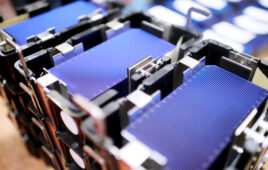 SolarEdge announced that its Energy Storage division has begun shipping new battery cells designed for stationary Energy Storage applications.
SolarEdge announced that its Energy Storage division has begun shipping new battery cells designed for stationary Energy Storage applications.
The new line of Nickel Manganese Cobalt (NMC) pouch cells, manufactured at Sella 2, the company’s new battery cell manufacturing facility in South Korea, has been optimized for energy storage applications for the residential, commercial and utility scale segments. The cells support high cycle life (up to 8000 cycles), high energy density, high-power throughput and a wide temperature range without compromising operational life, enabling SolarEdge to provide battery solutions that support a broad range of use cases, including demanding grid-stability applications.
“The global stationary storage market is estimated to grow from approximately 45 GWh in 2022 to 164GWh by 2030 and SolarEdge is focused on supporting this critical segment,” said Ronen Faier, SolarEdge chief financial officer and general manager of SolarEdge’s Energy Storage division. “Owning key processes and cell chemistries will allow us to further secure the resilience of our supply chain and provides us with the flexibility to produce cells optimized for various energy storage solutions.”
News item from SolarEdge





““Owning key processes and cell chemistries will allow us to further secure the resilience of our supply chain and provides us with the flexibility to produce cells optimized for various energy storage solutions.””
From some of the R&D over just the past 5 years, I believe SolarEdge may be making a mistake in choosing NMC cell chemistry. NMC and wet electrolyte chemistries still have a real risk of thermal run away and catastrophic ESS failure from just one cell in a battery pack array of some 1,000 to 100,000 cells making up battery packs in an ESS unit. It has been reported at the battery pack level (BM-LMP). Here’s the deal, company C4V claims their battery technology is 20% (less expensive) than NMC chemistries, they are more stable than NMC, have higher gravimetric energy densities at the cell level and one article stated the energy density of a battery pack made with this technology is ‘greater than’ is right at 190/Wh/kg with ‘greater than’ 8000 charge/discharge cycles, if combined with the so called LiSER intrinsic cooling technology, one should have a battery pack that can be built with 80% or greater cell weight and have greater pack energy density with less ancillary weight of ‘systems’ to monitor and temperature control the battery pack. NMC is not your best bet anymore, it is quickly becoming obsolete as more battery companies are chasing solid-state battery chemistries. Just sayin’.